Painting your cabinets is a perfect way to makeover a dated kitchen without splurging on a big renovation. It doesn’t cost much and, with the proper preparation, your paint job will look great and last a long time. We’ve used the tutorial outlined below to paint cabinets in 4 separate kitchens (not to mention cabinets in other rooms too) so we’re confident it’s a DIY project that will work for you. Follow along below!

The kitchen featured in this tutorial is from our second house which had solid oak cabinets throughout (along with wood paneling!). So while steps focus specifically on painting wood cabinets, the process is similar for any cabinet material. You can also refer to our tutorials about painting already-painted cabinets and painting Ikea cabinets.
Steps To Painting Cabinets
Here is a brief overview of how to paint your kitchen cabinets. The process takes time, patience, and a little bit of elbow grease – but nothing is especially complicated or tiring. At worst, it’s just a bit repetitive – especially if you a big kitchen.
- Remove cabinet doors and hardware
- Patch cracks and holes (optional)
- Lightly sand all surfaces
- Apply a liquid deglosser
- Prime one coat
- Paint two coats
- Rehang cabinet doors
- Reinstall cabinet hardware
This project can be completed by one person but may go faster with help. Proper surface preparation is the key to success here, so don’t rush steps 2-5.
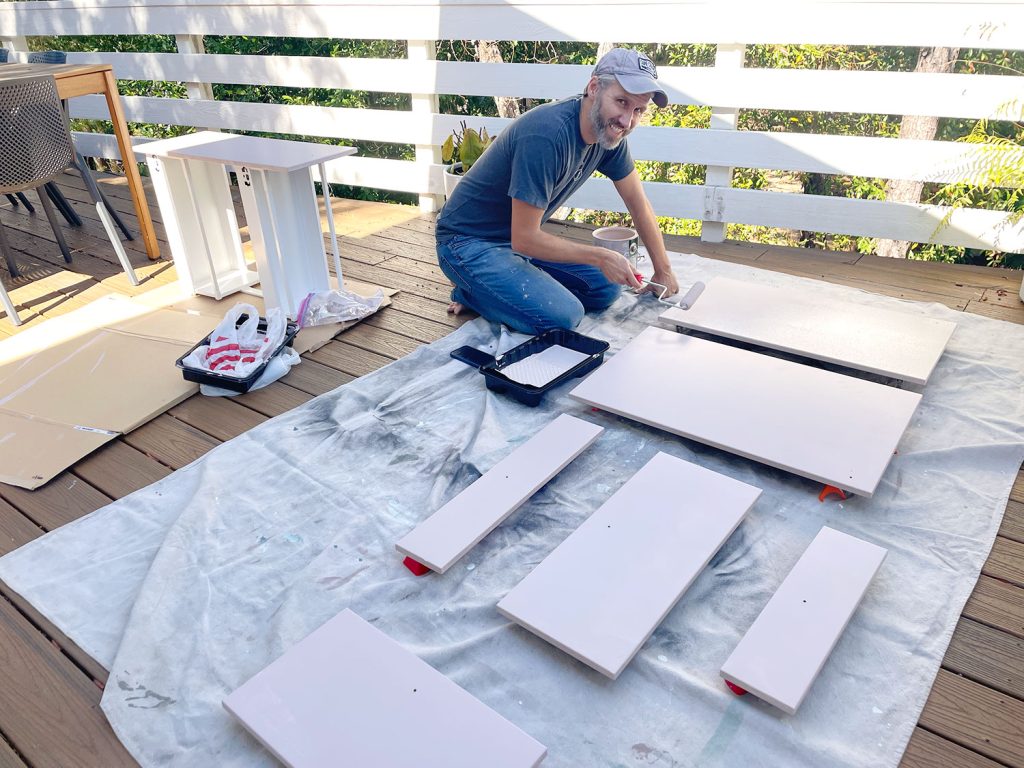
The overall time lime depends on the size of your kitchen, but even painting a small kitchen will span several days due to drying and curing time between coats. You also want to make sure you have ample space to spread out your cabinet doors, like in a garage or spare room.
How To Paint Cabinets Video Overview
You can see these steps in motion by watching the detailed video below. To view an abbreviated version of this process, you can see a quick version of painting cabinets on YouTube.
Note: You can also watch the video above on YouTube.
Supplies Needed To Paint Cabinets
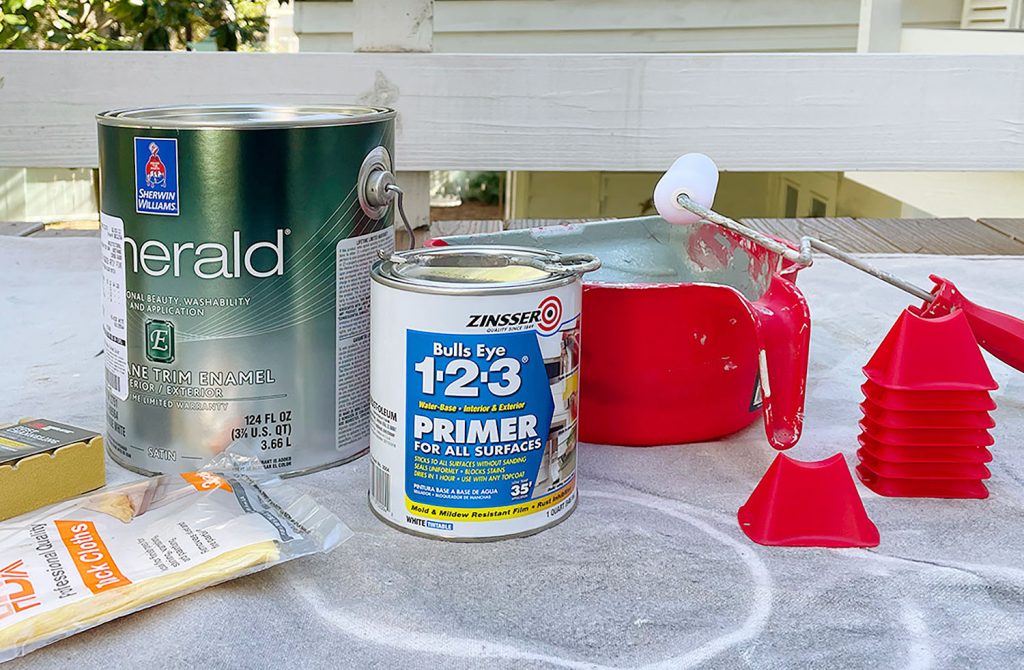
The materials you’ll need to paint your kitchen cabinets aren’t much different from other painting projects. So you may have many of these supplies already on hand.
- Primer
- Paint (we recommend satin or semi-gloss finish)
- Small 4? or 6? foam rollers
- Roller trays
- Short, angled paint brush
- Drop cloths
- Painter’s tape
- Painter stands or tripods
- Electric sander & sandpaper
- Electric drill & driver
- Liquid deglosser
- Wood filler (optional)
- Putty knife (optional)
You could use a paint sprayer for this project, but we don’t feel it’s necessary. If you already own a paint sprayer and are comfortable using it, go for it. It can save time. But we’ve never regretted painting by hand instead.
What paint should I use to paint my cabinets?
Water-based, latex paints formulated for cabinets or trim are best for painting kitchen cabinets. Oil-based paints used to be recommended, but are not necessary or practical for a DIYer. They are smelly, difficult to clean up, and can yellow over time. Also, water-based paints have come a long way and offer a similarly smooth and durable finish. Our favorite cabinet paints are Sherwin-Williams Emerald Urethane Trim Enamel and Benjamin Moore Advance. If you prefer a different brand, consult the paint desk expert for the best formula for your job. Buy the highest quality paint your budget allows.
Step 1: Remove cabinet doors & hardware
Carefully unscrew all cabinet doors from the frames using an electric driver. Remove existing hinges, knobs, pulls, or other hardware. If you are reusing this hardware, be sure to collect it in a bag or box for later. You may also want to label each door with painter’s tape (I.e. “lower left stove cabinet”) to help avoid confusion during reassambly.
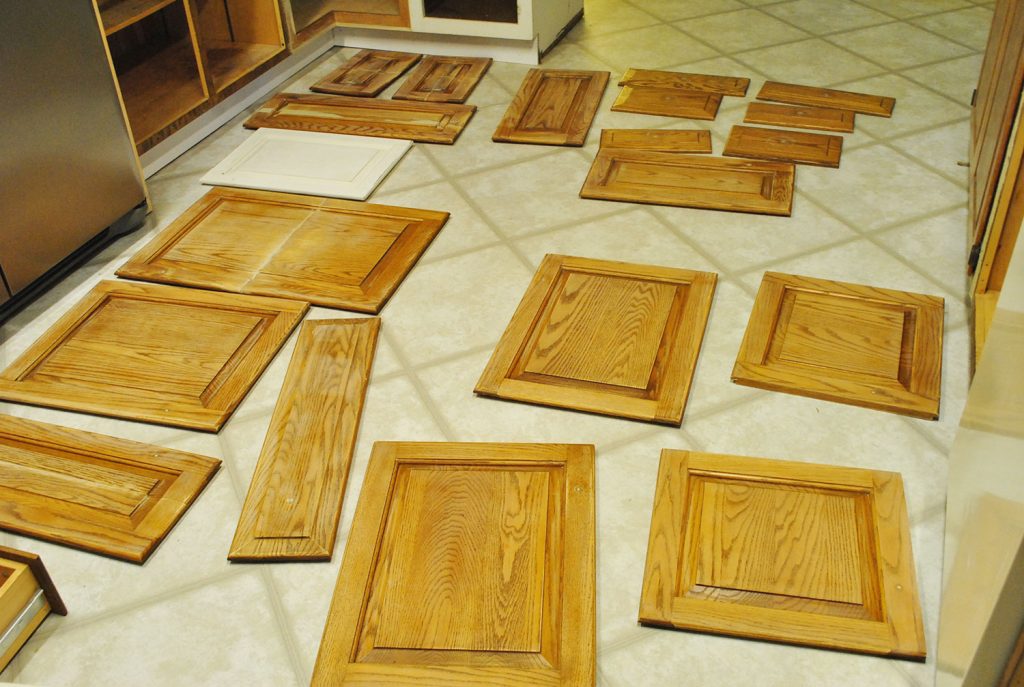
You will also need to slide out any drawers from the frames. If possible, unscrew the drawer front from the box. You may also need to empty some drawers and cabinets. We don’t typically paint the inside of the cabinets, so most things can stay in place while you work. But take care to cover or temporarily move items while you sand, to keep them from getting dusty.
Step 2: Patch cracks and holes (optional)
You can skip this step if your cabinets are in good condition and you’re reusing the existing hardware placement. For our cabinets, however, we planned to swap the existing single-hole knobs for two-hole pulls. The existing hole was in the wrong place, so we used wood filler to patch all of the existing hardware holes before proceeding. We were also changes the hinges, so we patches the holes for those too on both the doors and frames.
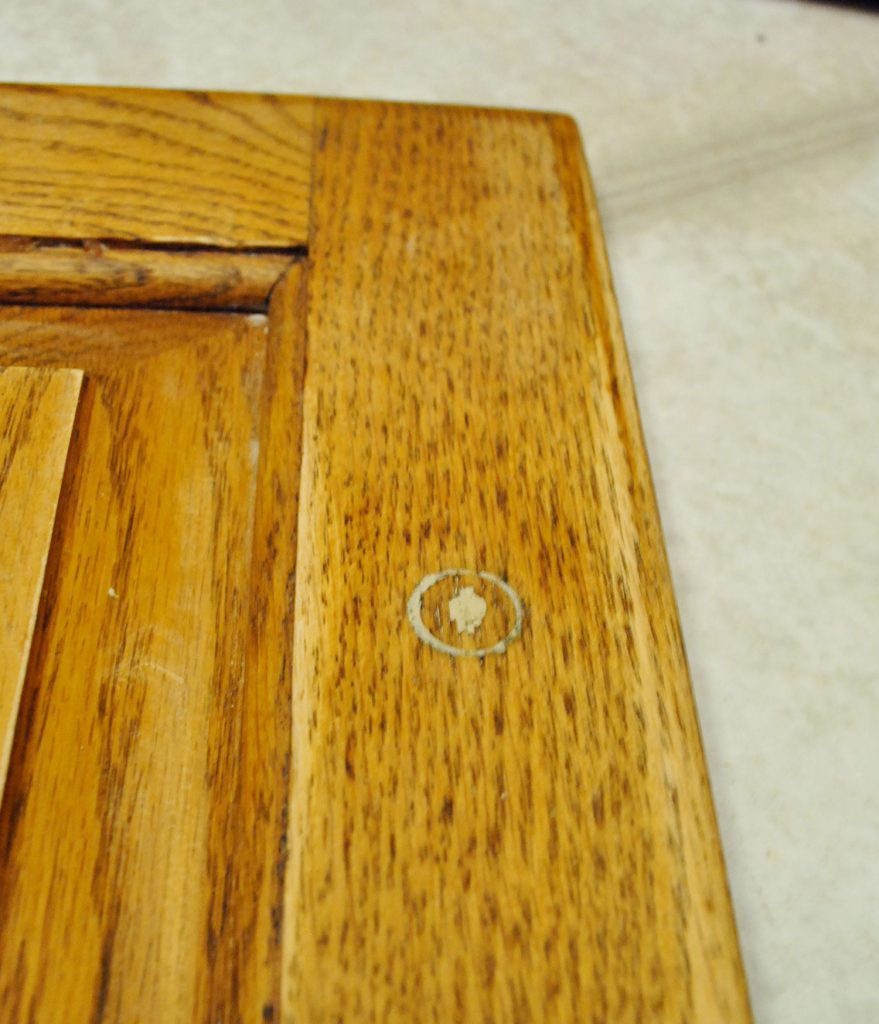
To apply the wood filler, use a putty knife to push it into the hole and smooth it. Once dried, sand off the excess. You may need to do a second coat, since it may shrink slightly as it dries.
Step 3: Lightly sand all surfaces
Prepping your wood cabinets for paint is the MOST IMPORTANT step if you want a long-lasting, durable result. Skipping the next few steps puts your paint job at risk of scratching or rubbing off, especially in high-traffic areas. So while this part is probably the most labor-intensive, please don’t shortchange it! We also have more detail in a dedicated post about prepping cabinets for paint. Here is an overview:
Use an electric sander and medium-grit sandpaper (like 120) to lightly sand every surface you will be painting. This means doors, drawer fronts, faces of cabinets, sides of cabinets, etc. You do NOT need to remove all of the existing finish. The goal is NOT to get it back to raw wood (although that it is okay). The goal is simply to rough up the surface enough to help primer and paint bond to it. You may need to hand sand small corners and nooks.
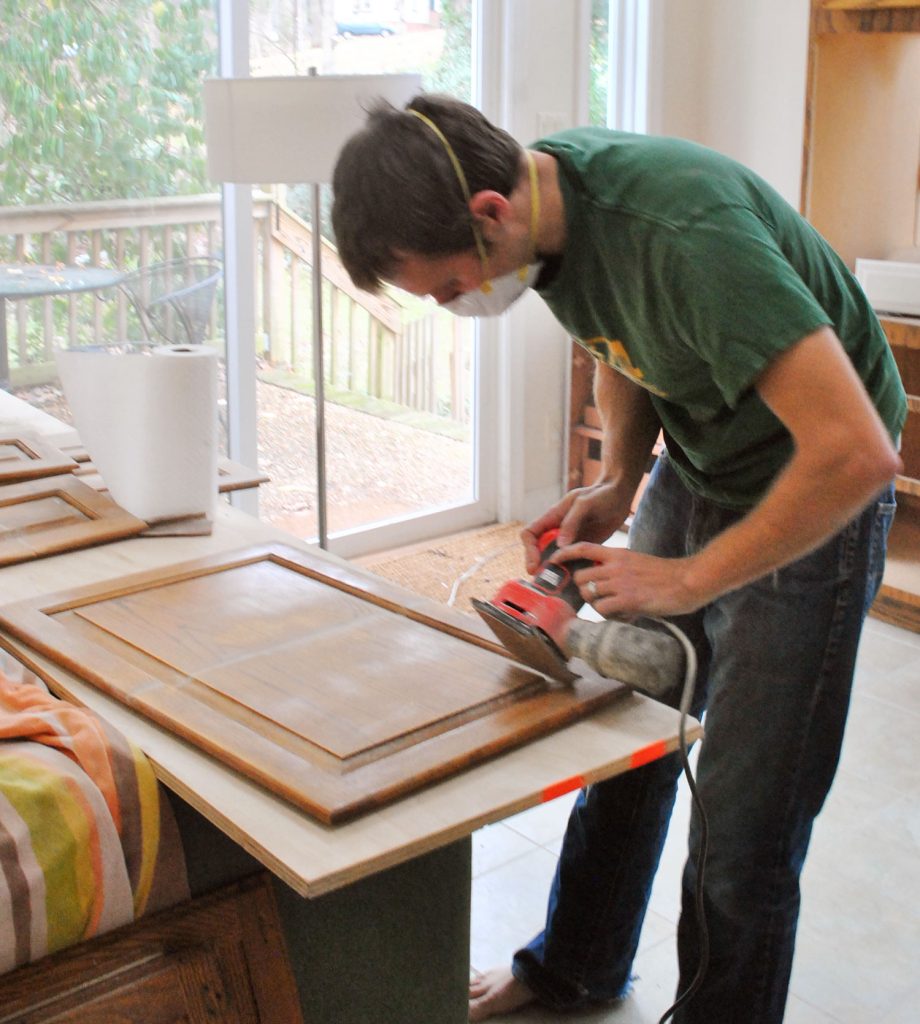
This process will be dusty, so try to do it outside or in a well-ventilated space (we did most of ours in our sunroom, above). When it comes time to sand the frames in place, cover items in your kitchen as needed to keep sanding dust from getting everywhere. After you’re done sanding, wipe your cabinets clean using a tack cloth.
Step 4: Apply a Liquid Deglosser
Liquid deglosser (sometimes called “liquid sandpaper”) helps etch the surface of your cabinets & frames, helping ensure a strong bond with the paint. Krud Kutter Gloss Off is our preferred deglosser. The one pictured below is difficult to find.
Some people use a liquid deglosser in place of sanding, but for wood cabinets we recommend doing both to be safe. It also helps remove any built-up grease or oil residue you may have missed while sanding, especially in nooks and crannies. You may also have heard of using a chemical called TSP (trisodium phosphate) instead. However, TSP is more of a cleaner than a deglosser, so we don’t recommend it.
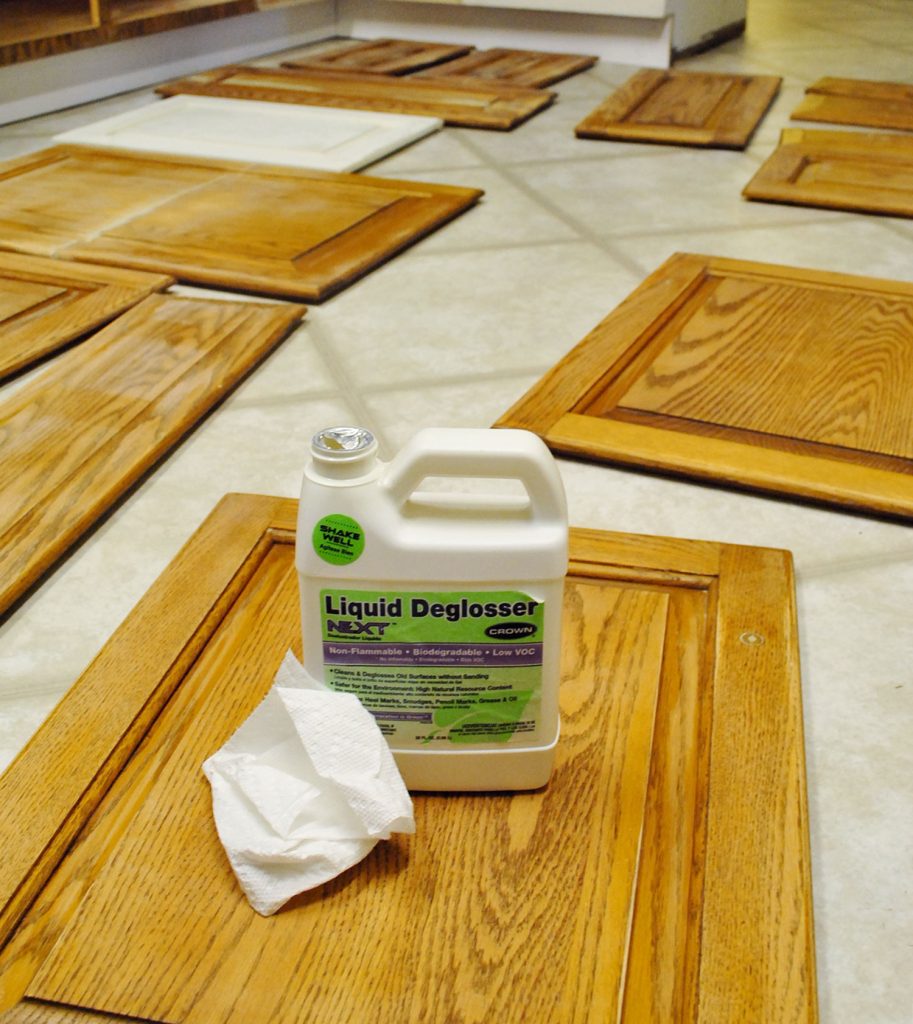
You can apply it with a rag or paper towel or put it in a spray bottle. It doesn’t need to be rinsed or wiped off. Just give it a few minutes to soak in. We sometimes do two applications to be safe.
Step 5: Prime One Coat
The last prep step before painting is priming! Primer is a critical element to good coverage and a long-lasting finish. Do not skip it! We like a Zinsser all-surface primer. It can be used off-the-shelf if you are painting your cabinets white or another light color. For darker or more saturated paints, consider having your primer tinted to match.
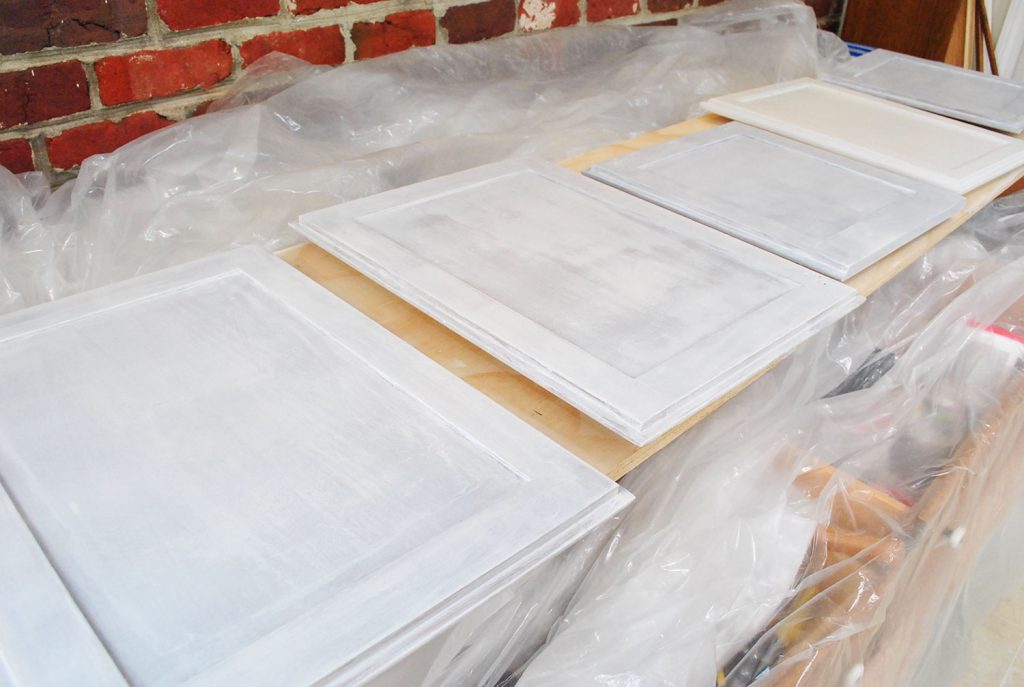
As you can see above, you’re not going for perfect coverage. Primer will be splotchy as it dries. This is okay. The main goal is to get a thin, smooth, and even coat. To do this, we recommend (1) using an angled paintbrush to get into edges or corners, then (2) using a small foam roller to remove brush strokes and coat the large, flat surfaces. Go slow and watch for drips along edges!
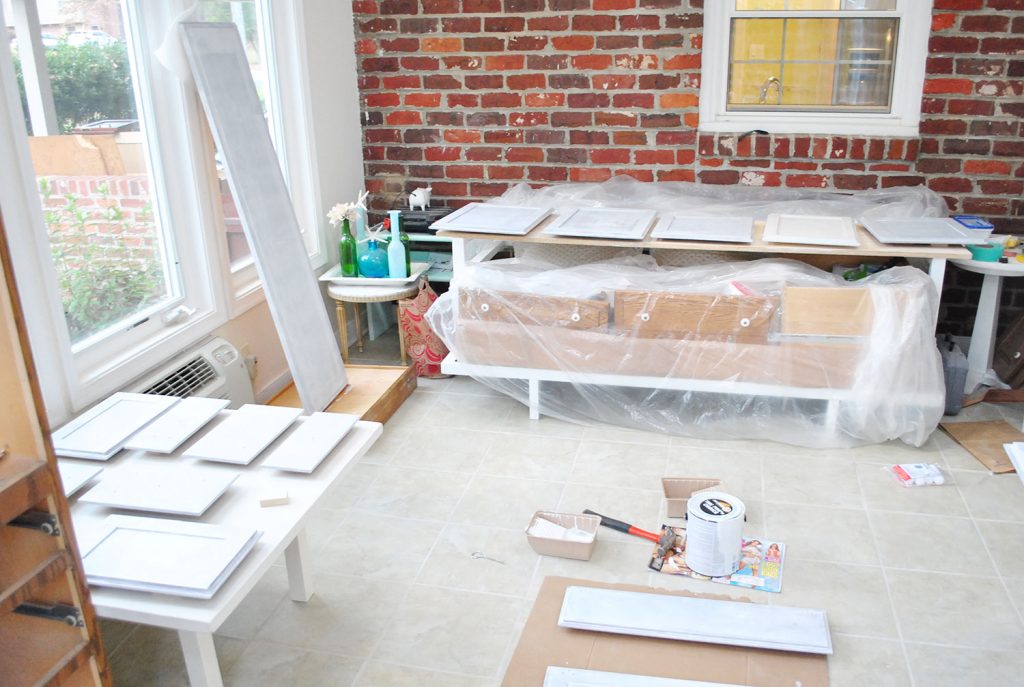
We suggest propping your doors off the ground with painter stands to make priming and painting easier. And if you’re painting both sides of your doors (which we think you should!) we’ve developed a specific order that helps minimize marks or dings on your freshly painted doors. It requires a bit of patience as you wait for one side to fully dry before flipping it over to do the other.
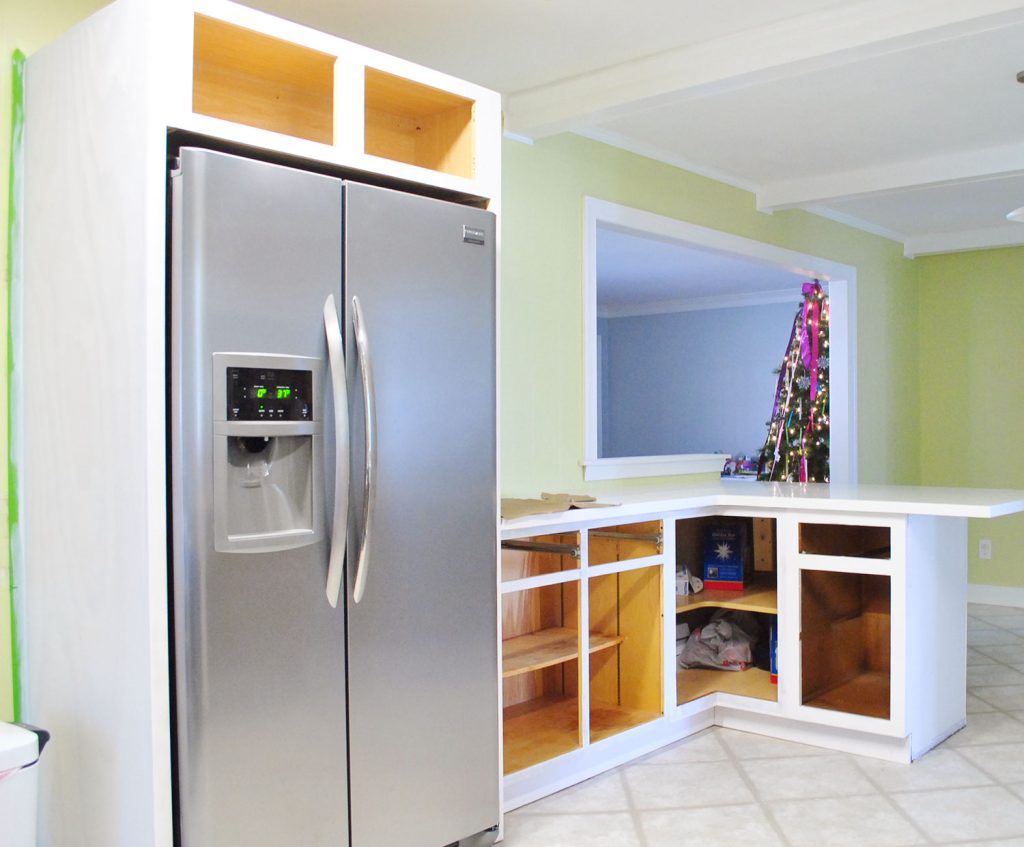
Don’t forget to do your cabinet frames and boxes too! You may want to use painter’s tape and drop cloths to protect walls, floors, appliances, and countertops.
Step 5: Paint Two Coats
Once your primer coat has fully dried and cured (see the manufacturer’s instructions on the can for specific times), you may repeat this process with your chosen paint. We used the color Benjamin Moore Cloud Cover. Again, use a combination of a brush and foam rollers to get a smooth finish. The paint may look slightly textured from the foam roller, but it will even out as it dries. Just remember: your main goal is thin & even coats without drips!
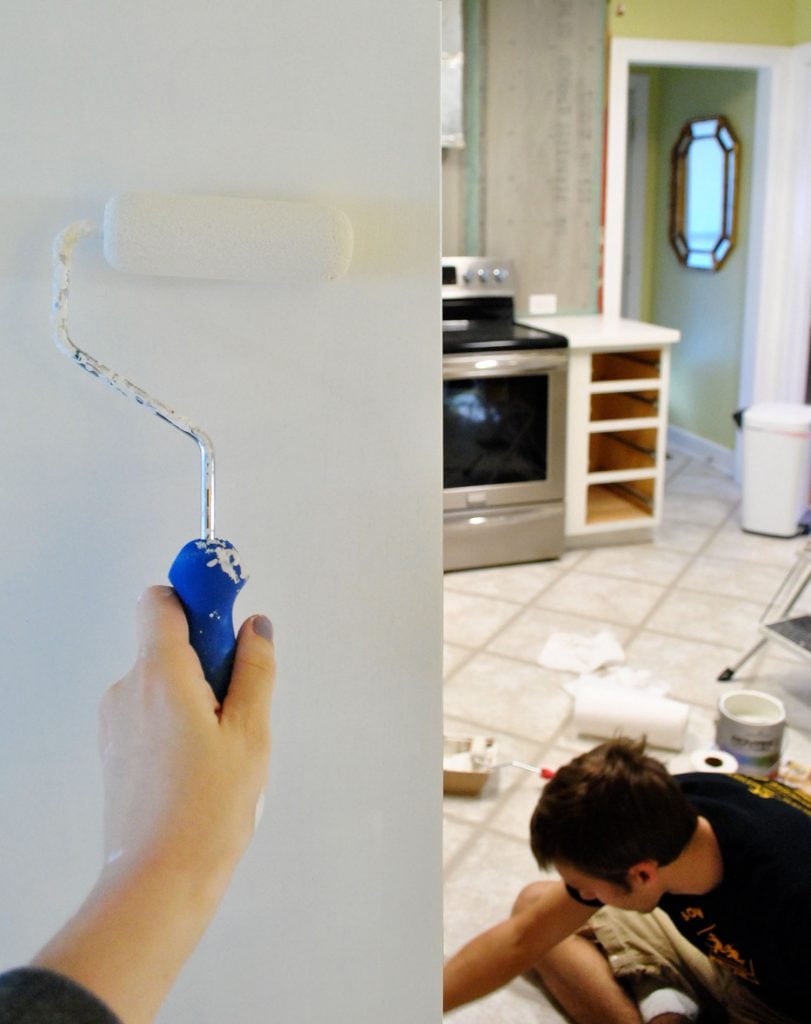
As a rule of thumb, we do two coats of paint for any painting project. But it’s especially important with painting cabinets. More thin layers is stronger and less prone to scratches than one thick layer. Just be sure to allow enough dry time between coats before touching or recoating.
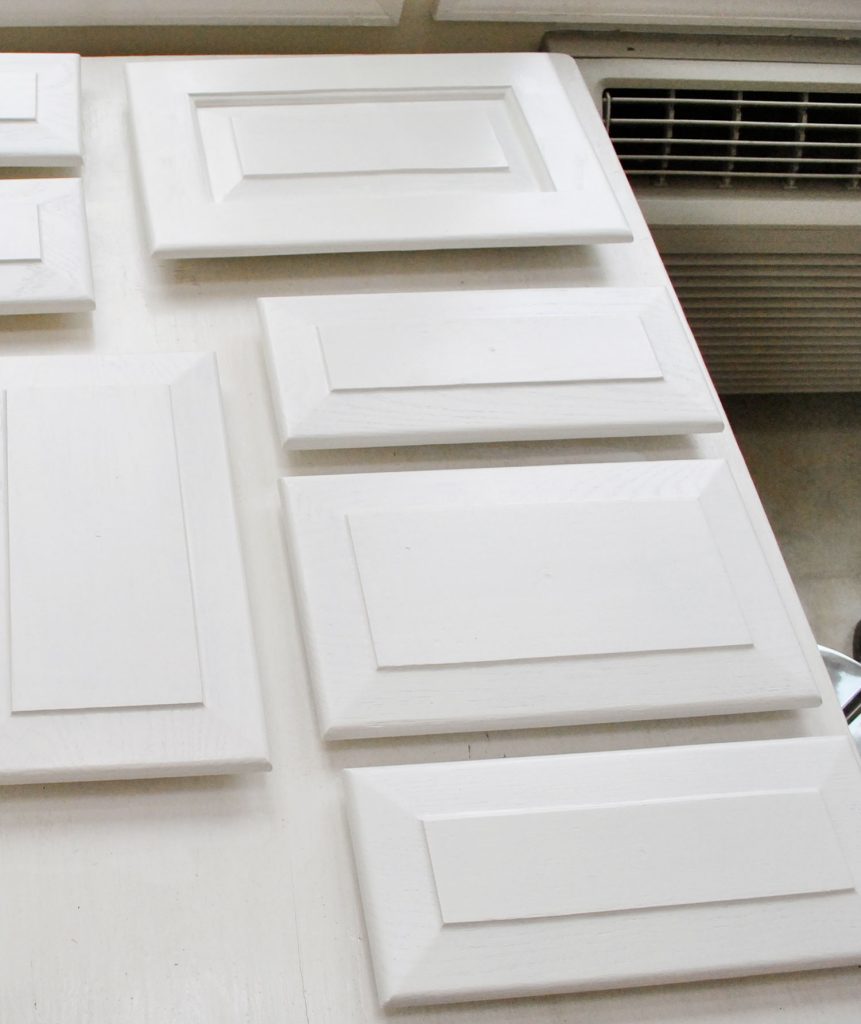
This part should be super satisfying. You’re finally seeing your hard work pay off and your vision come to life!
Step 7: Rehang cabinet doors
Once everything has fully dried, you can reassemble your kitchen. Screw hinges back on. Slide drawers back in place. You can even put things back in your cabinets.
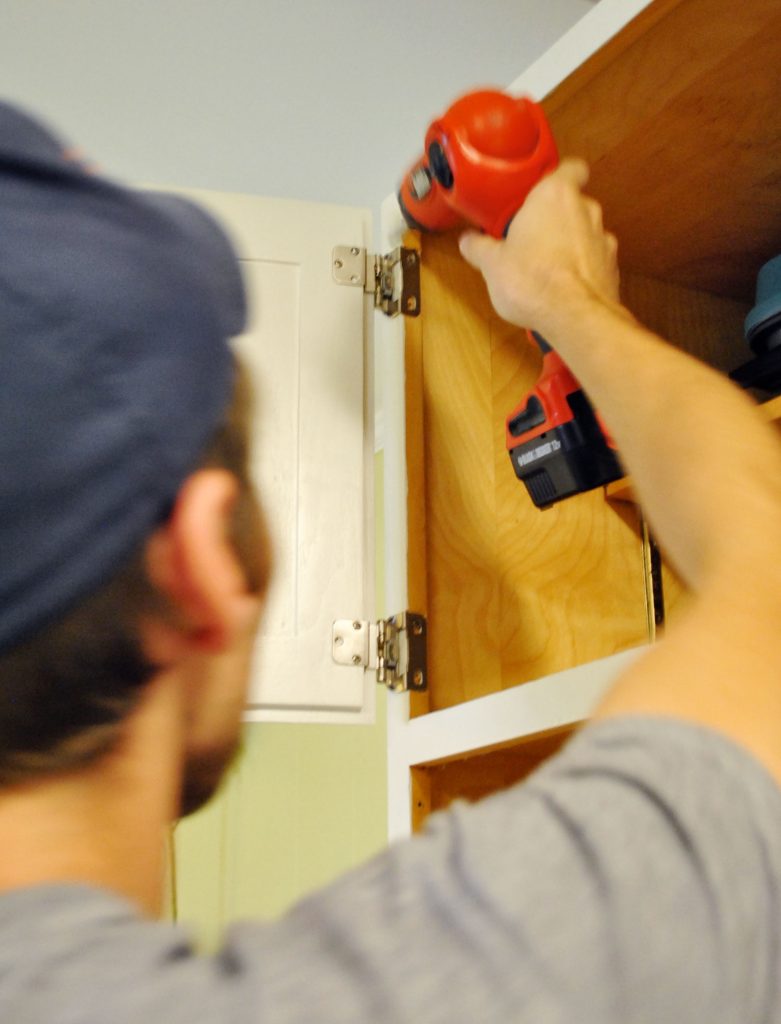
Things might get banged around in this process, so we often like to give our paint an extra day to cure before beginning. You’d hate to scuff up or scratch off the fresh paint right away!
Step 8: Reinstall cabinet hardware
At the same time, you can all reattached your cabinet knobs or pulls. However, this will be a bit more involve if you – like us – filled all of the old holes and need to make new ones.
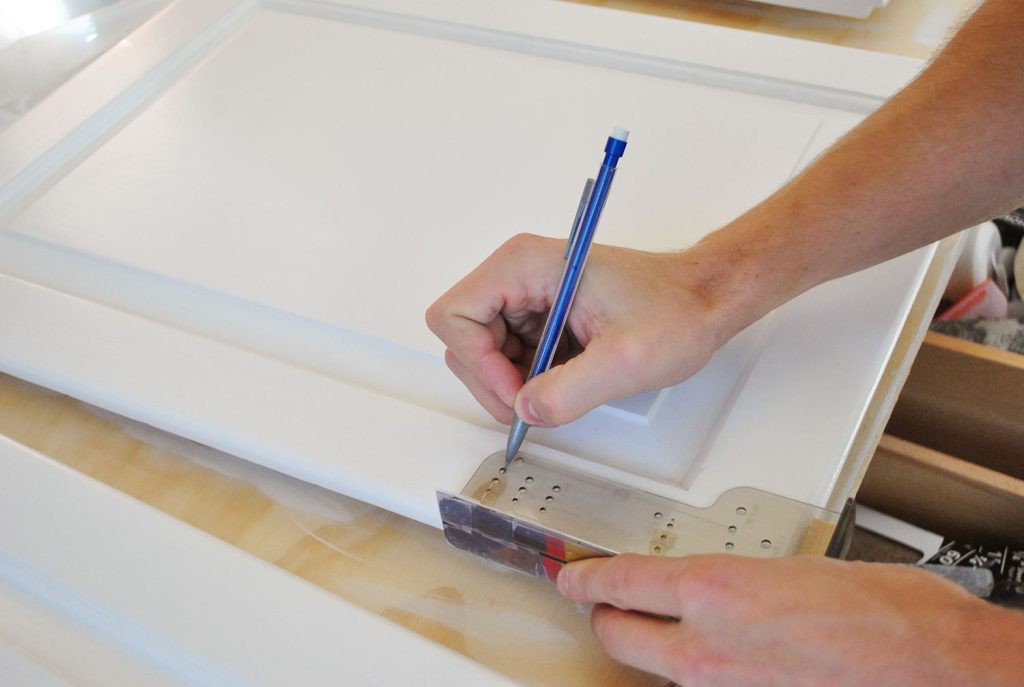
We have an entire post – with video! – dedicated to how to install cabinet hardware that will help you do this with precision and speed. But as you can see above, we highly recommend purchasing a hardware template for this step.
How long does it take to paint kitchen cabinets?
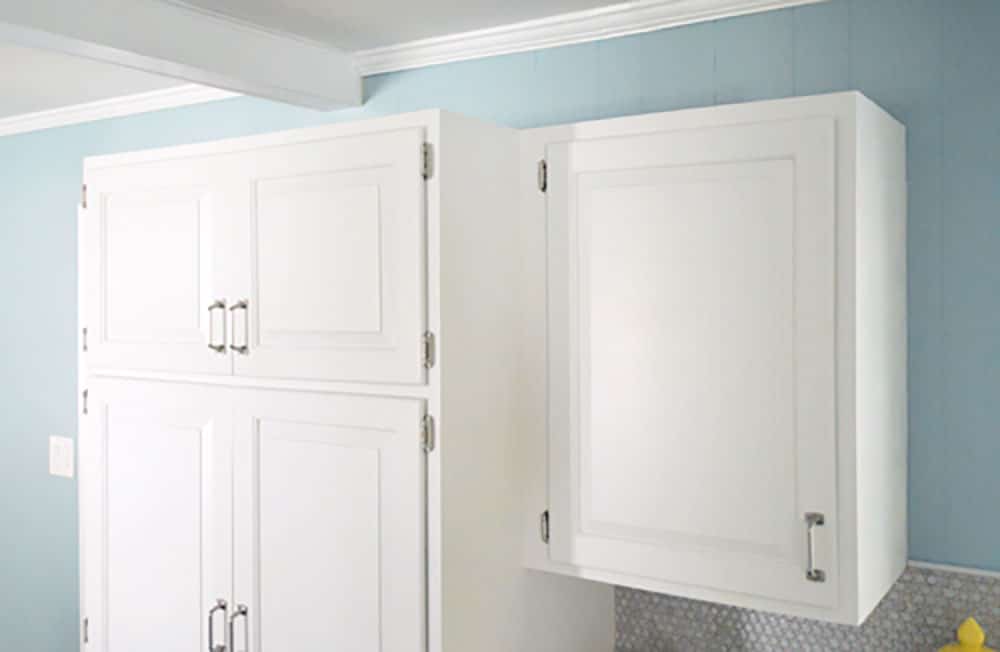
Painting these kitchen cabinets took us 15 days to complete. A lot of that time, however, was waiting for things to dry and cure. They were not 15 days of straight work! So while this isn’t a project you should expect to knock out in a weekend, it’s also not something you need to take 2 weeks off of work to complete. It can easily be done on nights and weekends, like we did. We even had a toddler at the time!
How much does painting cabinets cost?
Painting kitchen cabinets yourself is very affordable, especially compared to the alternative of hiring it out OR replacing your cabinets entirely. We completed this project in 2012 for just $300 and half was for new hinges and pulls. So if you are reusing your hardware, you can expect to spend even less. Here is a rough estimate of what you might spend to paint kitchen cabinets.
- Sandpaper: $10
- Liquid deglosser: $10
- Primer, 1 gallon: $30
- Paint, 1 gallon: $80 – $120
- Paint supplies (roller, brush, trays, etc): $40 – $60
- TOTAL COST: $170 – $230
If you don’t already own an electric sander or drill, those may cost you about $50 each. You can complete those tasks by hand to keep your budget down, but it will significantly increase your time and effort.
Other Cabinet Painting FAQs
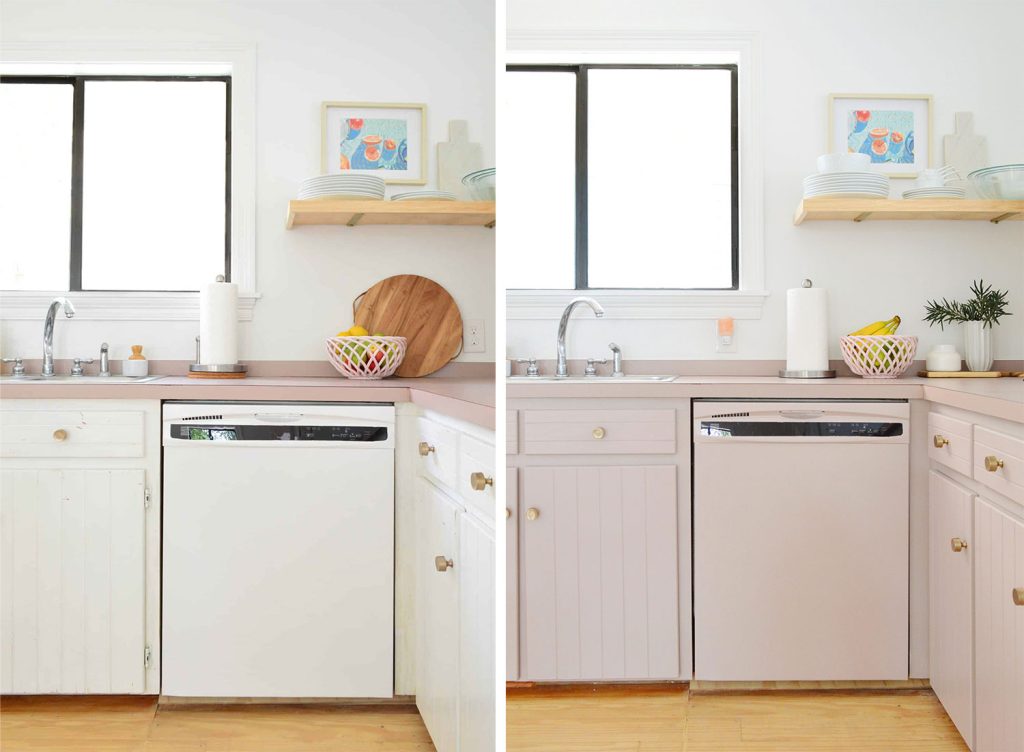
Here are some other frequently asked questions about painting kitchen cabinets:
Do I need to apply a sealer or topcoat?
No, you do not need to apply a sealer, varnish, or polyurethane to your painted cabinets. Paints, especially those formulated for cabinets or trim, don’t require a protective topcoat. In fact, applying one could cause your color to yellow.
What finish paint should I use on cabinets?
We recommend using a satin or semi-gloss paint for a hard, wipeable finish on cabinets. Gloss or high-gloss paint can offer a sleek, modern look with high shine, but should be applied professionally with a paint sprayer to avoid brush or roller strokes. Matte, flat, or eggshell finishes will be harder to wipe clean.
What color should I paint my cabinets?
There is no limit to the colors you can paint kitchen cabinets! We love classic white cabinets, but colorful cabinets have also been trending lately – like our current cabinets (Artsy Pink by Sherwin-Williams) or our friends’ painted cabinets below (Halcyon Green by Sherwin-Williams).
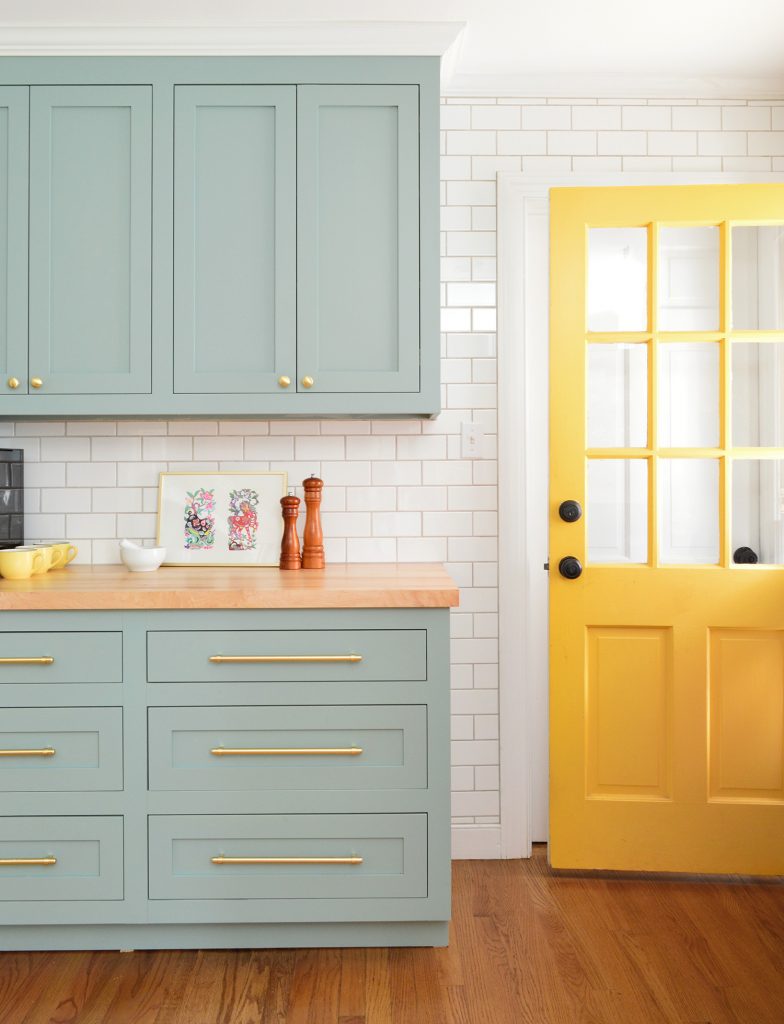
We always recommend testing any color before proceeding. Colors often appear brighter or more saturated than they seem on a small swatch. Whites also can appear stark or cold, so we recommend something with subtle yellow or gray. Any of these expert’s favorite white paints work well on cabinets.
More Kitchen Cabinet Projects
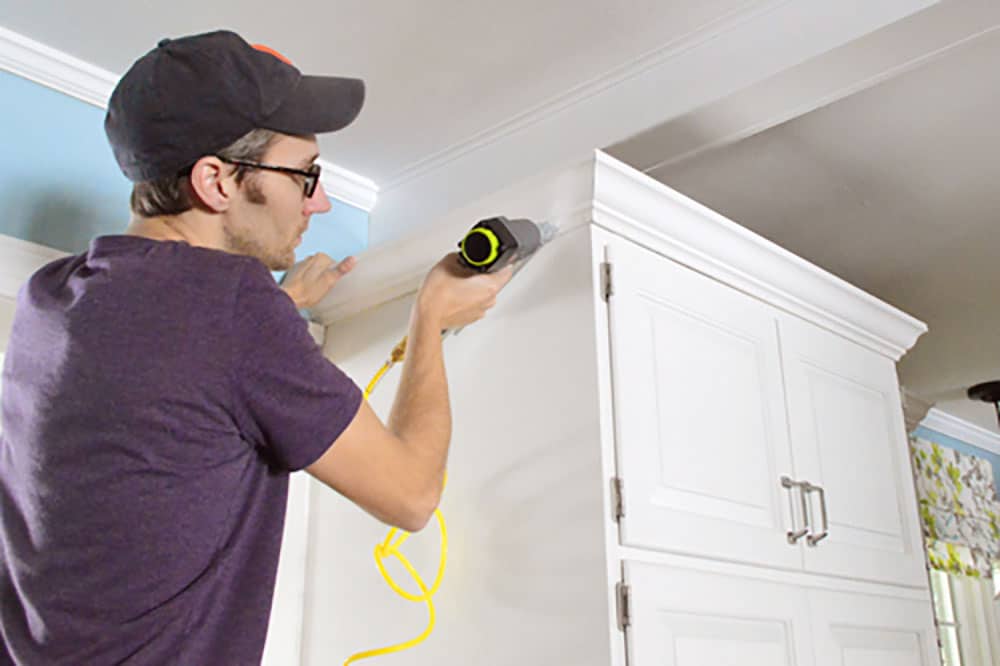
Looking for other budget-friendly ways to update your kitchen? Here are some other projects you might be interested in:
- How to Add Crown Molding To Cabinets
- How to Properly Prep Cabinets For Paint
- How To Paint Ikea Cabinets
- How to Install Kitchen Hardware
- Organizing a Small Kitchen
- Installing Hidden Ginges on Old Cabinets
- Staining Wood Cabinets Darker without Sanding
Update: Our painted cabinets are still holding up great. Check out a little update post here.
*This post contains affiliate links, so we may earn a small commission when you make a purchase through links on our site at no additional cost to you.

Pam Turnbull says
Love all three of your kitchen redos~ so fresh and fun!! My daughter and I will be painting her cabinets before she puts her house on the market. Our dilemma- with white appliances (not replacing) should cabinet color be a neutral or white that won’t fight with appliances?? Can’t wait until your ‘bun’ is done!! Good luck!!
YoungHouseLove says
Aw thanks Pam! I’d do white so the appliances blend in. Bring home some swatches and hold them up to the stove and see which ones look best (you don’t want any that are too white or too yellow in comparison). Good luck!
xo
s
Felicia says
We actually just finished a complete kitchen renovation and we able to salvage the original cabinetry by cleaning them up and painting them. The end result came out even better then we had anticipated!! Here’s our before and after photos! http://thetinyprofessional.blogspot.com/2014/02/kitchen-before-after.html
The Tiny Professional
YoungHouseLove says
That looks awesome! Congrats Felicia!
xo
s
Molly says
Sherry and John,
HELP!
My kitchen cabinets are already white, but they were spray painted white – not painted with regular white paint. Should I still sand and degloss? Also, should I use spray paint (like the cabinet makers did before), or use regular paint like you did? Thanks so much!
Molly :)
YoungHouseLove says
Yes, I’d still sand and degloss since kitchen grease can build up and hurt your hold. Good luck!
xo
s
Lisa at Texas Decor says
I can’t believe there’s almost 1000 comments on this! Yowza! Okay, here’s my question…how/where did you get a coupon for BM advance paint? :) I’m “this close” to convincing my hubby to paint our maple kitchen cabinets white. (wish me luck on the convincing part–ha!) I plan on using BM Advance paint and the same primer you used (zinsser smart prime) The only thing is that our appliances are white, so I’m not sure which color paint to go with. I want something that will match the appliances. I was thinking “simply white” but I’m not sure. Also, have you heard anything (good or bad) about using Krud Kutter to clean grease off the cabs before priming? Any advice you can offer is very much appreciated! Oh, and sorry about writing you a book here. :)
YoungHouseLove says
We are Facebook friends with a local paint shop that sells Ben Moore paint and we get alerts when they have coupons and deals!
xo
s
Noor says
Great job, looks so fresh.
I was wondering what you did to the countertops, did you change them?
YoungHouseLove says
Thanks Noor! We went with white corian and really liked it.
xo
s
Megan says
I hate to ask if you’ve already addressed this but 13 pages of comments is way too many to go through! :-) What do you feel about bonding primer to be able to skip sanding? I have kind of glossy, fake looking, wood cabinets that I’d really love to take from honey blond to gorgeous white. Feeling nervous. I’ve never done a project like this. Thanks for any wisdom you can pass along!! :-)
YoungHouseLove says
I’d sand if they’re glossy. Will definitely help it not scratch off :)
xo
s
Corin says
This is such a great tutorial! I do have one question-do you have any experience painting thermofoil cabinets? We are looking for a solution to our peeling, cracking gross cabinets (without buying new ones) and I’ve done some research on peeling off the thermofoil and painting. Ever done that? Any tips on it? Thanks!!! And hope Sherry is feeling well!
YoungHouseLove says
Never done that. Anyone tried it?
xo
s
Ashley says
My husband and I are moving in to my grandfather’s 1980’s ranch home. Brick, paneled walls, oak cabinets. The whole shebang. He has kept bisque appliances all these years and we just cant afford to replace them. We have black granite countertops and those oak cabinets. I wanted to paint them, but I have no idea what to do since we’ve got the bisque appliances. Ideas? We kept our wall color pretty neutral. Bermuda sand by valspar–a very light creamy yellow. I currently have avocado, teal, and mustard colors going on in the towels and kitchen curtains. I’d appreciate any input.
YoungHouseLove says
Hmm, they sell appliance paint (we used it to turn our almond fridge into a white fridge) so that could work and then you can paint the cabinets white to match so they blend in – or you could choose a soft color like cream or tan for the cabinets to go with the bisque appliances and the light creamy yellow walls.
xo
s
Ashley says
Thanks! We thought about appliance paint, but I’m worried about the heat factor on our in-wall oven unit and the stove top. I think we’ll try the cream; maybe continue the wheat color we painted the paneling with. It’s a start. :-)
Amy says
Hello, what is the green paint colour in the ‘after’ kitchen picture??? Thanks:)
YoungHouseLove says
That’s Sesame by Benjamin Moore :)
xo
s
Judy Salmon says
LOVED the tutorial ~ Your cabinets look AMAZING! Thanks for the inspiration & the tips.
Helen says
Thank you so much for sharing the specifics of how you painted your cabinets! I painted mine several years ago but didn’t really know what I was doing. I just redid them using your tutorial and it was SO much easier! Your video was especially helpful. Thank you! :-)
Shirley says
I found your “Painting kitchen cabinets” on pinterest..love the remodel…Thanks for the help.
Mrs. Frugalwoods says
Love this post! We modeled our cabinet project off of yours–thank you!
We also used Benjamin Moore Advance and I’m wondering how it’s holding up for you over time? Are you using any specific products to clean the cabinets? I’m wary of scrubbing too hard when the occasional foodstuff flings itself onto a cabinet…
Thanks so much!
YoungHouseLove says
Ours really held up well (we used it at our last house on our office cabinets and kitchen cabs and they held up for years, even with some pretty decent scrubbing). A lot of it has to do with the prep work (sanding, deglossing, priming) so as long as you did that too it should hold up great!
xo
s
Kelly says
I apologize if this has already been answered, but…no poly? No sealer at all? Ben Moore’s Advance must be one amaze balls paint! I know you guys have moved out of this house since, but I’m curious to know how those held up.
YoungHouseLove says
They did great! Still looked mint when we sold! Most cabinet painting pros actually don’t use or recommend poly (it can peel or yellow over time) so any good paint that’s not a flat finish (ex: good satin or semi-gloss paint) should do the trick without any topcoat. The Advance stuff is made for furniture and cabinets without sealer :)
xo
s
Anne says
I’m using your tutorial to redo my kitchen cabinets. I NEED to find the cabinet hinges you used in this post. Is there ANYWAY you can send me a link to the exact ones you bought? I attached the hardware’s website below. Please help, finding ones that work (we have the same cabinet frames you did) is driving me crazy!!
http://www.pleasantshardware.com/
YoungHouseLove says
So sorry I couldn’t find them! It’s been a while so maybe they’re not there or are only in stores?
xo
s
Chipper says
Wow! The kitchen looks so much bigger! You guys have inspired me to repaint my kitchen as well :) I don’t think I’ll be ripping out any cabinets though!
Man, I love before and after pictures.
Lydia K says
HOKAY. I just hauled all the supplies home to start on my cabinets TOMORROW. I’ve been looking at your time/day by day breakdown, and mine will be roughly the same, give or take a few things. (I don’t need to patch any old hardware holes! Hooray!!)
I did have a question on curing. I don’t have a nice sunroom to work in like you guys did in your last house, so I’ll be painting all the doors and drawer fronts in the garage. While it is an insulated garage, I’ll definitely need the door open for some light & ventilation, and it’s turning into a typical July here in North Carolina, so you know where I’m going with this. Should I allow more than the 3 days of cure time to fight the heat & humidity in my garage, or should I forget that entirely and bring them inside to cure after they’re dry to the touch? And do you think I should wait longer than a day between coats of primer and paint? It’s the one thing I’m stressing over.
YoungHouseLove says
Yes, I would give them even more time. Maybe touch them after 4 days and if there’s any tackiness it’s better to hold out than smear/dent them! As for the time between primer and paint I think you should still be fine. Good luck!
xo
s
Melinda M says
I’m looking to paint my 80’s oak cabinets as well. I’m wondering about the prep order. Some tutorials I read recommended deglossing before sanding but I noticed that you sanded before deglossing. Which is better?
Also have you heard of brushing putty to eliminate wood grain? It is said to give the painted cabinets an almost glass-like finish. Do you think it is necessary?
Melinda
YoungHouseLove says
We did the deglossing after sanding because it allows you to wipe all the sanding dust off and make sure after that step it’s all clean and ready for primer/paint. As for brushing putty we have never tried that so I’m not sure if it works or how hard it would be. Sounds intriguing though! Good luck!
xo
s